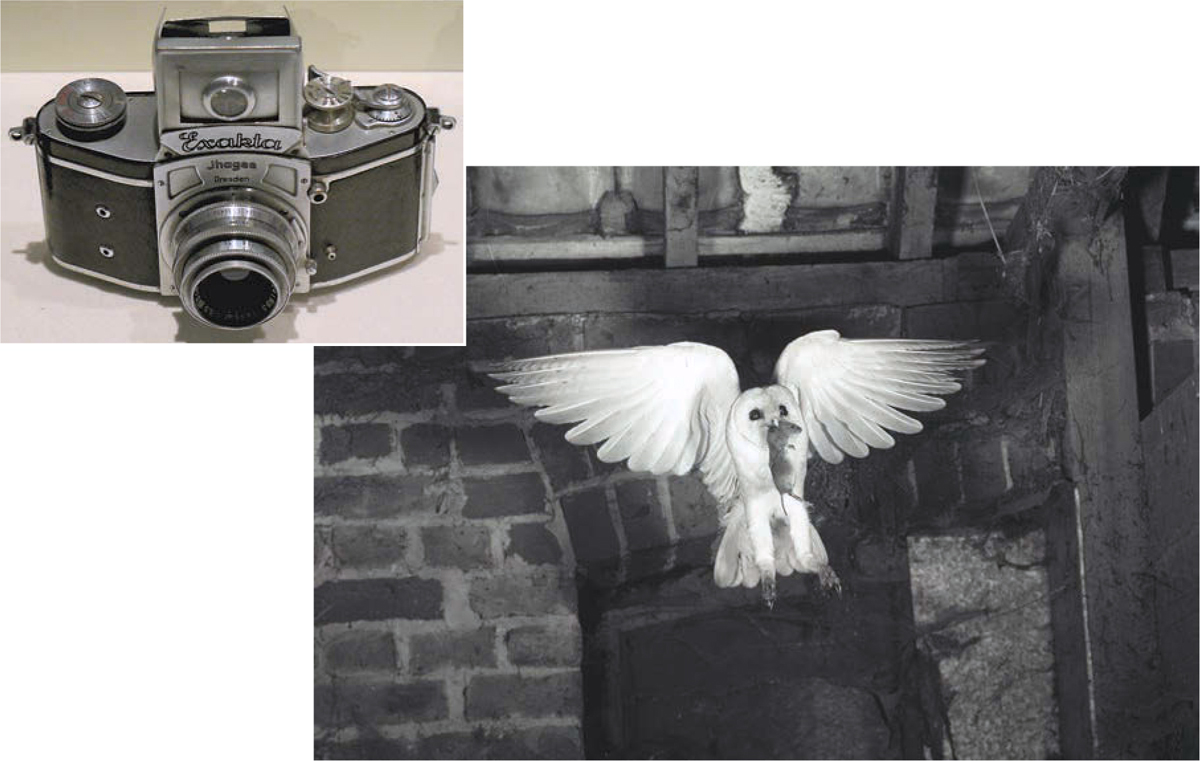53 : Leica SLR camera
1935
Cheaper SLRs like Jhagee’s VP Exakta (top) also entered the marketplace in 1935 to compete with Leica, while around the same time self-taught masters of bird photography like Eric Hosking were taking breathtakingly iconic SLR images such as this Barn Owl with prey.
A giant step forward for photographers was the invention of the single lens reflex (SLR) camera, which enabled them to see through a viewfinder the image they were shooting exactly as it would appear on film.
Previously, cameras had to make do with the viewfinder and film not sharing the same optical path – that is, the path of light through the lens – but the positioning of a mirror and prism between the lens and the film enabled the photographer to see the results in a more ‘real world’ view, with the inversions of the lens corrected.
The principle for this was actually known before cameras were invented, the system of mirror and prism being used as a drawing aid from as early as the 16th century (often for natural history subjects). The first patented reflex mirror system for a camera was granted in Britain in 1861. Still, the first commercially available SLR was not manufactured and sold until 1884, while it was another half-century until the first mass-market 35mm SLR, Leica’s PLOOT reflex housing along with a 200mm f4.5 lens paired to a 35mm rangefinder camera body, made its debut in 1935.
Prior to that landmark innovation, bird photography was already attracting attention. The July 1906 issue of National Geographic (founded 1888) featured the still stunning images (many of birds) of George Shiras III, then in the House of Representatives but who was also an innovative and patient nature photographer, who was even called ‘about the most interesting man I know’ by Ernest Hemingway.
Shiras was a hunter who put down his guns in 1889, having become more empathetic towards wild animals and birds. He became enamoured with their study and capturing their likenesses, initially with wet plate cameras, but more enthusiastically when he acquired an early hand-held SLR. His restless desire to uncover animals as we never normally see them, by daylight and at night, led him to invent the first flash (called ‘flashlight photography’ by him), build his own tripwires, be the first to use both canoe and a mobile hide to take photographs, and the first to freeze birds in flight, showing their posture during take-off and in motion.
The 1906 magazine publication saw Shiras achieve almost overnight fame (the issue was reprinted two years later due to demand), and he eventually put together the classic Hunting Wild Life with Camera and Flashlight (1935) when his eyesight began to fail him.
His political career included conservation innovation, and he is one of the congressmen to have helped the Migratory Bird Act through the house in 1916, a forward-thinking piece of legislation ensuring protection for 800 species of bird in the USA and Canada, still in force in modified form today.
The key bird photographer for many British birders was Eric Hosking, and many fans will recall his autobiography An Eye for a Bird (1970). However, the Londoner had been photographing wild birds since 1917, when he was eight years old, quietly innovating techniques but remaining unpublished until a Tawny Owl took out his left eye while he climbed to his self-built hide, resulting in national publicity for himself, and inadvertently for his images, too. Many will know his iconic ‘Barn Owl with Prey’ (1936), and he was the first to use a fast electronic shutter release for flight photography, though he came relatively late to 35mm film in 1963.
Since the 1960s, SLRs have been the camera format of choice for bird photography, being both relatively affordable and practical, offering the benefit of interchangeable lenses and providing top-notch results with practice. The arrival of affordable, high-quality digital SLRs (or DSLRs) since 2003 has exponentially popularised photography among birders.
